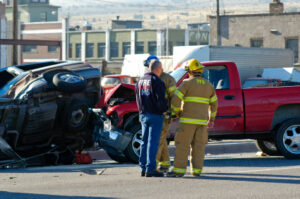Posted in Automobile, Michael J. Fontaine, Personal Injury, Series: "Why Do I Need a Personal Injury Lawyer?"

The person who causes an accident is often referred to as the “tortfeasor.” Actual causation usually requires the injured person to prove that his/her injuries would not have occurred “but for” the tortfeasor’s actions (or inactions); whereas proximate causation requires the injured person to prove that his injuries were a “foreseeable consequence” of the tortfeasor’s action (or inactions).
As discussed in Part 1 of this blog series, an example of a duty to act reasonably is found in our “rules of the road,” i.e. the duty to drive properly and maintain control over your vehicle so as to not cause a collision. A breach of that duty is failing to stop at a stop sign. Actual causation exists if a tortfeasor drives through a stop sign and causes an accident; and proximate causation exists if the resulting injuries were a foreseeable consequence to the automobile collision.
To use another example: Assume that you suffer from advanced osteoporosis (a disease that weakens bones and leaves them more susceptible to fractures and breaks). Your neighbor invites you over for a late-night dinner, and as you walk through your neighbor’s front yard, you trip on a three-inch (3”) hole and end up breaking your femur (thigh) bone (which is arguably the strongest bone in your body). In this case, you could likely prove actual causation because, but for your neighbor not warning you of the hole in his/her front yard, you would not have tripped and broken your leg. However, proving proximate causation could be more difficult because you suffer from a disease that leaves your bones more easily breakable; while it may be foreseeable that you could break a toe or your foot from tripping on a three-inch hole, it may not be foreseeable that such an accident could break the strongest bone (thigh bone) in your body.
These hypotheticals illustrate an important point: proving actual and proximate causation is extremely dependent on the facts of your case. Several factors can be relevant to your causation analysis including: what the tortfeasor knew of your personal medical history, whether there were multiple tortfeasors that contributed to your injury, and whether there were “intervening acts” that led to your injury. However, just because your case may be complicated does not mean legal recovery is impossible.
You should speak with a personal injury lawyer you trust as soon as possible after you become injured to best assess the likelihood of legal recovery in your specific case. Our office offers free consultations and will travel to you if necessary. We will promptly interview you to obtain all of the relevant facts of your case, and will obtain all accident reports, interview witnesses, accumulate medical records and bills, and establish lost wages/earnings and compile evidence of other losses/damages you may have incurred to fully evaluate your case.
For more information on these topics and more, including legal issues related to damages and who to sue and when, please stay tuned for future postings in this series of blogs: “Why Do I Need A Personal Injury Lawyer?”.
Author: Michael J. Fontaine, Esq.
